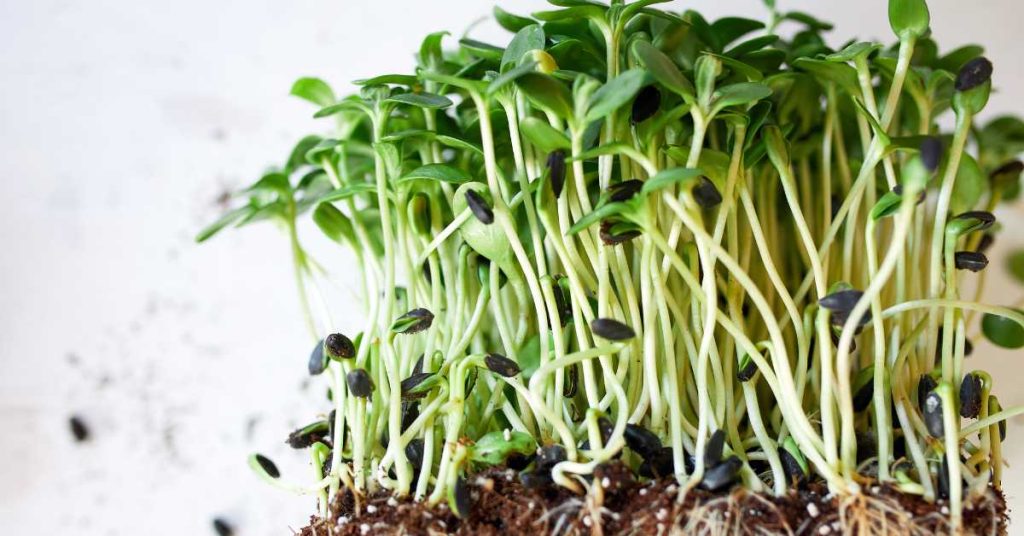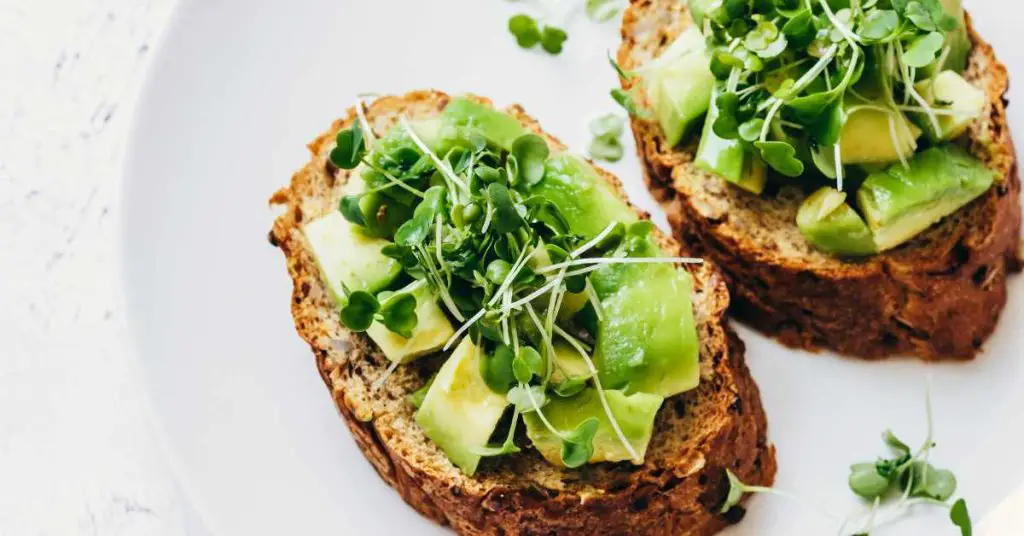Are Microgreens and Sprouts the same thing? Despite their similar appearance at first glance, microgreens and sprouts are distinct in several key aspects. While both are valued for their nutritional benefits and culinary versatility, they differ significantly in their growth stages, cultivation methods, nutritional profiles, and culinary applications.
As someone who’s nurtured both microgreens and sprouts in my kitchen garden for years, I’ve experienced firsthand their unique characteristics and benefits. In this article, I’ll share these insights, unraveling the mystery behind these two superfoods. Whether you’re a health enthusiast, a home cook, or simply curious, join me as we delve into the intriguing world of microgreens and sprouts.
What are Microgreens?
- Definition: Microgreens are young vegetable greens, approximately 1–3 inches tall, harvested just after the cotyledon leaves have developed, and sometimes after the first true leaves have appeared.
- Growth: Unlike sprouts, microgreens are grown in soil or soil substitutes, requiring a good amount of sunlight or artificial light. It takes about 7-21 days for them to mature, depending on the variety.
- Types: Some of the most popular microgreens include arugula, radish, basil, beet greens, and cilantro. Each variety offers a unique flavor, from spicy to sweet, adding a gourmet touch to dishes.
In my kitchen, I find microgreens to be a fantastic way to elevate the taste and appearance of meals. Microgreens are tasty and super nutritious. I love adding them to a fresh salad or putting some fresh microgreens on a sandwich to take it up a notch.
One of my favorite microgreens is cilantro. I know not everyone loves cilantro like I do, but there is just something about cilantro microgreens on a sandwich or in an omelet. I love it!

What are Sprouts?
- Definition: Sprouts are germinated seeds that are eaten whole, including the root, stem, and undeveloped leaves. They are the very first stage of a plant.
- Sprouting Process: Sprouts are cultivated in water, often in a jar, and are ready for consumption within 2-7 days. This short growth period means they’re mostly eaten raw to retain their crunchy texture and nutrients.
- Popular Types: Among the many varieties, alfalfa, lentil, mung bean, and broccoli sprouts are common. Each type of sprout offers a different flavor and texture, making them versatile in various dishes.
Sprouts have been a staple in my salads and sandwiches for a long time, the provide a fresh, crunchy texture and a boost of nutrients.

Are Microgreens and Sprouts the Same Thing?
No, microgreens and sprouts are not the same. The primary difference lies in their stages of growth and parts of the plant that are consumed. Sprouts are the initial growth of a seed, consisting of the root, seed, and young shoot, and are typically harvested within 2-7 days of germination.
They are grown in water and consumed entirely, including the seed and root. Microgreens, on the other hand, are slightly more mature, harvested after the first true leaves develop, usually within 7-21 days.
They are grown in soil or a soil substitute, and only the stems and leaves are eaten. While both are nutrient-rich and used in a variety of dishes, they differ in texture, flavor, and growing conditions, making them distinct in both culinary and nutritional aspects.
What are The Nutritional Differences Between Microgreens and Sprouts?
Nutritionally, both microgreens and sprouts are impressive, but they offer different benefits:
- Microgreens: Rich in various vitamins such as C, E, and K, and also contain antioxidants. They provide intense flavors and a range of phytonutrients.
- Sprouts: High in protein, fiber, and essential vitamins and minerals, sprouts are a great addition to a balanced diet.
Combining both in a diet can provide a comprehensive array of nutrients, catering to different health needs.
Growing Microgreens vs. Sprouts: What’s the Difference?
- Microgreens: They need a growing medium like soil or a soil substitute, a shallow tray, and either natural or artificial light. Regular watering and a controlled environment are necessary for their growth.
- Sprouts: Require just a jar and water, no soil or light. They grow well even in limited spaces and can be a fun, easy project for beginners.
Growing microgreens requires more patience and care, but the result is incredibly rewarding. Sprouts are simpler and quicker to grow, making them ideal for those new to gardening.
Related: How To Grow Microgreens For Beginners

What are The Culinary Uses of Microgreens and Sprouts?
Microgreens and sprouts differ significantly in their culinary uses:
- Microgreens: With their more developed flavor profiles, microgreens are perfect for adding a burst of flavor and color to dishes. They work well in salads, sandwiches, and as garnishes on various dishes.
- Sprouts: They’re commonly used for their crunchy texture and mild taste, perfect for adding to wraps, salads, and even smoothies.
I love using microgreens for a gourmet touch, while sprouts are my go-to for a quick and healthy addition to meals.

Are There Any Safety Considerations in Growing and Consuming Microgreens and Sprouts?
Both microgreens and sprouts have safety considerations:
- Microgreens: Generally safer as they are less prone to bacterial growth. However, it’s important to ensure clean growing conditions and proper handling.
- Sprouts: Have been associated with outbreaks of foodborne illnesses due to the warm, humid conditions in which they’re grown. It’s crucial to handle and store them properly.
I always emphasize buying sprouts from reputable sources or growing them in hygienic conditions to minimize health risks.
What Are the Best Microgreen Varieties to Grow?
There are so many different varieties of veggies and herbs that you can grow as microgreens and they all are nutritious and delicious. So, when it comes to choosing microgreen varieties to grow, it is best to start with something you like.
For example, I love growing kale, chard, pea shoots, and cilantro microgreens. I love these, my family love these so it makes sense.
Frequently Asked Questions
Which is Better: Microgreens vs Sprouts?
Deciding whether microgreens or sprouts are better depends largely on individual dietary needs and culinary preferences. Microgreens, known for their rich flavors and high concentrations of vitamins such as C, E, and K, are excellent for enhancing the taste and nutritional value of meals.
On the other hand, sprouts are packed with protein and fiber, making them a great addition for those looking to boost these elements in their diet. While microgreens offer a more diverse range of flavors suitable for gourmet dishes, sprouts provide a crunchy texture and are ideal for quick, nutritious additions to salads and sandwiches.
Ultimately, both are highly nutritious and can be chosen based on specific health goals and flavor preferences.
What is the Difference Between Broccoli Sprouts and Micro Broccoli?
Broccoli sprouts and micro broccoli differ primarily in their growth stages and nutritional profiles. Broccoli sprouts are the germinated seeds of the broccoli plant, harvested just a few days after sprouting.
They are highly valued for their high concentration of sulforaphane, a compound known for its antioxidant properties. Micro broccoli, on the other hand, is harvested slightly later, typically when the first true leaves have emerged, offering a more intense broccoli flavor.
While both are nutritionally beneficial, micro broccoli tends to have a broader spectrum of vitamins compared to the more concentrated phytochemical profile of broccoli sprouts.
Are Microgreens Considered Raw Seed Sprouts?
Microgreens are not considered raw seed sprouts. They are a distinct stage in the plant’s growth, typically harvested after the first true leaves have developed, which is later than the sprout stage. Unlike sprouts, which are grown in water and consumed entirely (including the seed and root), microgreens are grown in soil or soil substitutes and only the stems and leaves are eaten.
This difference in growth method and part of the plant consumed distinguishes microgreens from raw seed sprouts both nutritionally and in terms of culinary use.
What is Another Name for Microgreens?
Microgreens are sometimes referred to as “micro herbs” or “vegetable confetti.” These terms capture their petite size and the variety of colors and flavors they bring to a dish. The term “micro herbs” is often used when referring to microgreens grown from herb seeds like basil or cilantro, highlighting their intense flavor and aromatic qualities.
“Vegetable confetti,” on the other hand, emphasizes their decorative appeal in culinary presentations, enhancing the visual appeal of a dish with their vibrant colors and textures.
Are Microgreens Safer to Eat Than Sprouts?
Microgreens are generally considered safer to eat than sprouts. This is largely due to the different growing conditions of the two. Microgreens are grown in soil or a soil substitute and require air circulation, which reduces the risk of bacterial growth.
Sprouts, grown in a moist, humid environment, are more susceptible to bacterial contamination, such as Salmonella and E. coli. While both require proper handling and hygiene, the risk of foodborne illness is typically lower with microgreens, making them a safer choice for raw consumption.
Is it Cheaper to Grow or Buy Microgreens?
Growing microgreens at home can often be more cost-effective than buying them, especially for regular consumers. The initial investment in seeds, soil, and a suitable container is relatively low, and these supplies can yield multiple batches of microgreens.
Additionally, growing microgreens at home allows for a fresher product and the satisfaction of growing your own food. In contrast, purchasing microgreens from a store or market can be more expensive due to their gourmet status and the labor involved in their cultivation and transportation.
Therefore, for those who consume microgreens regularly, home cultivation can be a budget-friendly and rewarding option.
Conclusion
In conclusion, while microgreens and sprouts may share some similarities, they are distinctly different in terms of growth stages, nutritional profiles, culinary uses, and safety considerations. Microgreens, with their rich flavors and diverse nutrient content, make an excellent addition to gourmet dishes, whereas sprouts, known for their high protein and fiber content, are great for adding a crunchy texture to salads and sandwiches.
Exploring the world of microgreens and sprouts opens up a new realm of culinary possibilities and health benefits. Whether you’re a seasoned gardener or just starting, these tiny greens can make a significant impact on your meals and well-being.
Whether you choose to grow them at home or purchase them from your local market, incorporating microgreens and sprouts into your diet is a delightful way to add nutrition and flavor to your meals.





